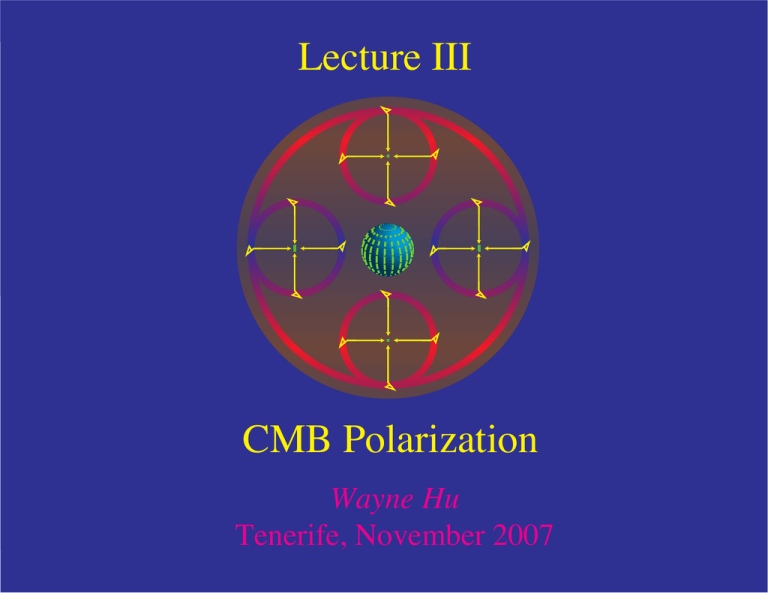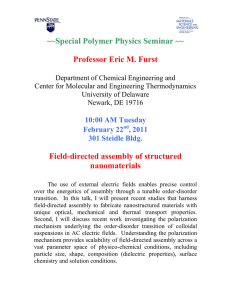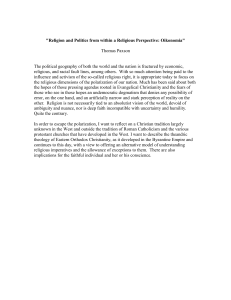Lecture III - Wayne Hu`s Tutorials
advertisement

Lecture III
CMB Polarization
Wayne Hu
Tenerife, November 2007
Polarized Landscape
100
∆ (µK)
10
reionization
ΘE
EE
1
BB
0.1
0.01
Hu & Dodelson (2002)
gravitational
waves
10
100
l (multipole)
gravitational
lensing
1000
Recent Data
Ade et al (QUAD, 2007)
Why is the CMB polarized?
Polarization from Thomson Scattering
• Differential cross section depends on polarization and angle
3 0 2
dσ
= |ε̂ · ε̂| σT
dΩ 8π
dσ
3 0 2
= |ε̂ · ε̂| σT
dΩ 8π
Polarization from Thomson Scattering
• Isotropic radiation scatters into unpolarized radiation
Polarization from Thomson Scattering
• Quadrupole anisotropies scatter into linear polarization
aligned with
cold lobe
Whence Quadrupoles?
•
•
Temperature inhomogeneities in a medium
Photons arrive from different regions producing an anisotropy
hot
cold
hot
(Scalar) Temperature Inhomogeneity
Hu & White (1997)
CMB Anisotropy
•
WMAP map of the CMB temperature anisotropy
Whence Polarization Anisotropy?
•
•
Observed photons scatter into the line of sight
Polarization arises from the projection of the quadrupole on the
transverse plane
Polarization Multipoles
•
•
•
Mathematically pattern is described by the tensor (spin-2) spherical
harmonics [eigenfunctions of Laplacian on trace-free 2 tensor]
Correspondence with scalar spherical harmonics established
via Clebsch-Gordan coefficients (spin x orbital)
Amplitude of the coefficients in the spherical harmonic expansion
are the multipole moments; averaged square is the power
E-tensor harmonic
l=2, m=0
Modulation by Plane Wave
• Amplitude modulated by plane wave → higher multipole moments
• Direction detemined by perturbation type → E-modes
Scalars
Polarization Pattern
1.0
0.5
π/2
φ
Multipole Power
B/E=0
l
A Catch-22
•
•
•
Polarization is generated by scattering of anisotropic radiation
Scattering isotropizes radiation
•
Polarization fraction is at best a small fraction of the 10-5 anisotropy:
~10-6 or µK in amplitude
Polarization only arises in optically thin conditions: reionization
and end of recombination
Reionization
Temperature Inhomogeneity
•
•
Temperature inhomogeneity reflects initial density perturbation
on large scales
Consider a single Fourier moment:
Locally Transparent
•
Presently, the matter density is so low that a typical CMB photon
will not scatter in a Hubble time (~age of universe)
observer
transparent
recombination
Reversed Expansion
•
Free electron density in an ionized medium increases as scale factor
a-3; when the universe was a tenth of its current size CMB photons
have a finite (~10%) chance to scatter
recombination
rescattering
Polarization Anisotropy
•
Electron sees the temperature anisotropy on its recombination
surface and scatters it into a polarization
recombination
polarization
Temperature Correlation
•
Pattern correlated with the temperature anisotropy that generates
it; here an m=0 quadrupole
WMAP 3year
100.00
{ l(l+1) Cl / 2π } 1/2
[μK]
10.00
1.00
0.10
0.01
1
10
100
Multipole moment (l)
1000
Page et al (WMAP, 2006)
Why Care?
•
Early ionization is puzzling if due to ionizing radiation from normal
stars; may indicate more exotic physics is involved
•
Reionization screens temperature anisotropy on small scales
making the true amplitude of initial fluctuations larger by eτ
Measuring the growth of fluctuations is one of the best ways of
determining the neutrino masses and the dark energy
•
•
Offers an opportunity to study the origin of the low multipole
statistical anomalies
•
Presents a second, and statistically cleaner, window on
gravitational waves from the early universe
Polarization Power Spectrum
•
Most of the information on ionization history is in the polarization
(auto) power spectrum - two models with same optical depth
but different ionization fraction
µK
'
10-13
50
l(l+1)ClEE/2π
50
0µ
K
'
partial ionization
step
10-14
10
Kaplinghat et al (2002) [figure: Hu & Holder (2003)]
l
100
Principal Components
•
Information on the ionization history is contained in ~5 numbers
- essentially coefficients of first few Fourier modes
δx
0.5
0
-0.5 (a) Best
δx
0.5
0
-0.5 (b) Worst
5
Hu & Holder (2003)
10
z
15
20
Representation in Modes
•
Reproduces the power spectrum and net optical depth
(actual τ=0.1375 vs 0.1377); indicates whether multiple
physical mechanisms suggested
x
0.8
0.4
l(l+1)ClEE/2π
10-13
0
10
15
20
z
25
10-14
true
sum modes
fiducial
10
Hu & Holder (2003)
l
100
Temperature v. Polarization
•
•
Quadrupole in polarization originates from a tight range of
scales around the current horizon
Quadrupole in temperature gets contributions from 2 decades
in scale
weight in power
3
2
1
0.01
temperature
recomb
(x30)
ISW
polarization
0.006
0.002
(x300)
reionization
0.0001
0.001
0.01
-1
k (Mpc )
Hu & Okamoto (2003)
0.1
Alignments
Temperature
Quadrupole
Octopole
E-polarization
Dvorkin, Peiris, Hu (2007)
Polarization Peaks
Acoustic Oscillations
•
•
When T>3000K, medium ionized
•
•
Medium behaves as a perfect fluid
Photons tightly coupled to free electrons via Thomson scattering;
electrons to protons via Coulomb interactions
Radiation pressure competes with gravitational attraction causing
perturbations to oscillate
Quadrupoles at Recombination's End
• Acoustic inhomongeneities become anisotropies by streaming/diffusion
Quadrupoles at Recombination's End
• Electron "observer" sees a quadrupole anisotropy
• Polarization pattern is a projection quadrupole anisotropy
Fluid Imperfections
• Perfect fluid: no anisotropic stresses due to scattering
isotropization; baryons and photons move as single fluid
• Fluid imperfections are related to the mean free path of the
photons in the baryons
λC = τ̇ −1
where
τ̇ = ne σT a
is the conformal opacity to Thomson scattering
• Dissipation is related to the diffusion length: random walk
approximation
p
p
√
λD = N λC = η/λC λC = ηλC
the geometric mean between the horizon and mean free path
• λD /η∗ ∼ few %, so expect the peaks >3 to be affected by
dissipation
Viscosity & Heat Conduction
• Both fluid imperfections are related to the gradient of the velocity
kvγ by opacity τ̇ : slippage of fluids vγ − vb .
• Viscosity is an anisotropic stress or quadrupole moment formed by
radiation streaming from hot to cold regions
hot
m=0
v
cold
hot
v
Dimensional Analysis
• Viscosity= quadrupole anisotropy that follows the fluid velocity
k
π γ ≈ vγ
τ̇
• Mean free path related to the damping scale via the random walk
2
kD = (τ̇ /η∗ )1/2 → τ̇ = kD
η∗
• Damping scale at ` ∼ 1000 vs horizon scale at ` ∼ 100 so
kD η∗ ≈ 10
• Polarization amplitude rises to the damping scale to be ∼ 10% of
anisotropy
k 1
πγ ≈
vγ
kD 10
` 1
∆P ≈
∆T
`D 10
• Polarization phase follows fluid velocity
Damping & Polarization
•
Quadrupole moments:
damp acoustic oscillations from fluid viscosity
generates polarization from scattering
•
Rise in polarization power coincides with fall in
temperature power – l ~ 1000
Ψ
πγ
damp
ing
polarization
driv
ing
Θ+Ψ
5
10
ks/π
15
20
Acoustic Polarization
• Gradient of velocity is along direction of wavevector, so
polarization is pure E-mode
• Velocity is 90◦ out of phase with temperature – turning points of
oscillator are zero points of velocity:
Θ + Ψ ∝ cos(ks);
vγ ∝ sin(ks)
• Polarization peaks are at troughs of temperature power
Cross Correlation
• Cross correlation of temperature and polarization
(Θ + Ψ)(vγ ) ∝ cos(ks) sin(ks) ∝ sin(2ks)
• Oscillation at twice the frequency
• Correlation: radial or tangential around hot spots
• Partial correlation: easier to measure if polarization data is noisy,
harder to measure if polarization data is high S/N or if bands do
not resolve oscillations
• Good check for systematics and foregrounds
• Comparison of temperature and polarization is proof against
features in initial conditions mimicking acoustic features
Temperature and Polarization Spectra
100
∆ (µK)
10
reionization
ΘE
EE
1
BB
0.1
0.01
gravitational
waves
10
100
l (multipole)
gravitational
lensing
1000
Recent Data
Ade et al (QUAD, 2007)
Why Care?
•
•
•
In the standard model, acoustic polarization spectra uniquely
predicted by same parameters that control temperature spectra
Validation of standard model
Improved statistics on cosmological parameters controlling peaks
•
Polarization is a complementary and intrinsically more incisive
probe of the initial power spectrum and hence inflationary (or
alternate) models
•
Acoustic polarization is lensed by the large scale structure into
B-modes
•
Lensing B-modes sensitive to the growth of structure and hence
neutrino mass and dark energy
•
Contaminate the gravitational wave B-mode signature
Transfer of Initial Power
Hu & Okamoto (2003)
Gravitational Waves
Gravitational Waves
•
•
•
Inflation predicts near scale invariant spectrum of gravitational waves
Amplitude proportional to the square of the Ei=V1/4 energy scale
If inflation is associated with the grand unification Ei~1016 GeV
and potentially observable
transverse-traceless
distortion
Gravitational Wave Pattern
•
•
Projection of the quadrupole anisotropy gives polarization pattern
Transverse polarization of gravitational waves breaks azimuthal
symmetry
density
perturbation
gravitational
wave
Electric & Magnetic Polarization
(a.k.a. gradient & curl)
• Alignment of principal vs polarization axes
(curvature matrix vs polarization direction)
E
B
Kamionkowski, Kosowsky, Stebbins (1997)
Zaldarriaga & Seljak (1997)
Patterns and Perturbation Types
• Amplitude modulated by plane wave → Principal axis
• Direction detemined by perturbation type → Polarization axis
Polarization Pattern
Scalars
1.0
0.5
π/2
Vectors
θ
1.0
0.5
Tensors
1.0
π/2
0.5
0
π/4
φ
π/2
Multipole Power
B/E=0
B/E=6
B/E=8/13
10
Kamionkowski, Kosowski, Stebbins (1997); Zaldarriaga & Seljak (1997); Hu & White (1997)
l
100
Scaling with Inflationary Energy Scale
RMS B-mode signal scales with inflationary energy scale
squared Ei2
1
0.1
1
0.01
g-waves
10
100
l
1000
Ei (1016 GeV)
3
∆B (µK)
•
0.3
Contamination for Gravitational Waves
Gravitational lensing contamination of B-modes from
gravitational waves cleaned to Ei~0.3 x 1016 GeV
Hu & Okamoto (2002) limits by Knox & Song (2002); Cooray, Kedsen, Kamionkowski (2002)
1
g-lensing
0.1
1
0.01
g-waves
10
100
l
1000
Ei (1016 GeV)
3
∆B (µK)
•
0.3
The B-Bump
Rescattering of gravitational wave anisotropy generates the B-bump
Potentially the most sensitive probe of inflationary energy scale
Potentially enables test of consistency relation (slow roll)
10
∆P (µK)
•
•
•
EE
1
BB
reionization
B-bump
10
recombination
lensing
B-peak
contaminant
100
l
1000
•
•
Slow Roll Consistency Relation
Consistency relation between tensor-scalar ratio and tensor tilt
r = -8nt tested by reionization
Reionization uncertainties controlled by a complete p.c. analysis
p.c.
inst
Mortonson & Hu (2007)
Temperature and Polarization Spectra
100
∆ (µK)
10
reionization
ΘE
EE
1
BB
0.1
0.01
gravitational
waves
10
100
l (multipole)
gravitational
lensing
1000
Gravitational Lensing
Gravitational Lensing
•
•
Gravitational lensing by large scale structure distorts the observed
temperature and polarization fields
Exaggerated example for the temperature
Original
Lensed
Polarization Lensing
Polarization Lensing
•
Since E and B denote the relationship between the polarization
amplitude and direction, warping due to lensing creates B-modes
Original
Lensed E
Zaldarriaga & Seljak (1998) [figure: Hu & Okamoto (2001)]
Lensed B
Reconstruction from Polarization
•
•
•
Lensing B-modes correlated to the orignal E-modes in a specific
way
Correlation of E and B allows for a reconstruction of the lens
Reference experiment of 4' beam, 1µK' noise and 100 deg2
Original Mass Map
Reconstructed Mass Map
Hu & Okamoto (2001) [iterative improvement Hirata & Seljak (2003)]
Why Care
• Gravitational lensing sensitive to amount and hence growth of
structure
• Examples: massive neutrinos - d ln C`BB /dmν ≈ −1/3eV, dark
energy - d ln C`BB /dw ≈ −1/8
• Mass reconstruction measures the large scale structure on large
scales and the mass profile of objects on small scales
• Examples: large scale decontamination of the gravitational wave B
modes; lensing by SZ clusters combined with optical weak lensing
can make a distance ratio test of the acceleration
Weighing Neutrinos
• Massive neutrinos suppress power strongly on small scales
[∆P/P ≈–8Ων/Ωm]: well modeled by [ceff2=wg, cvis2=wg, wg: 1/3→1]
• Degenerate with other effects [tilt n, Ωmh2...]
• CMB signal small but breaks degeneracies
• 2σ Detection: 0.3eV [Map (pol) + SDSS]
Complementarity
Power Suppression
SDSS
P(k)
1
0.1
1.4
1.2
SDSS
only
n
1.0
0.01
MAP only
0.8
mv = 0 eV
mv = 1 eV
Joint
0.6
0.1
k (h Mpc-1)
Hu, Eisenstein, & Tegmark (1998); Eisenstein, Hu & Tegmark (1998)
–0.01
0.0
0.01
0.02
Ωνh2 = mν/94eV
0.03
Lecture III: Summary
• Polarization by Thomson scattering of quadrupole anisotropy
• Quadrupole anisotropy only sustained in optically thin conditions
of reionization and the end of recombination
• Reionization generates E-modes at low multipoles from and
correlated to the Sachs-Wolfe anisotropy
• Reionization polarization enables study of ionization history, low
multipole anomalies, gravitational waves
• Dissipation of acoustic waves during recombination generates
quadrupoles and correlated polarization peaks
• Recombination polarization provides consistency checks, features
in power spectrum, source of graviational lensing B modes
• Gravitational waves B-mode polarization sensitive to inflation
energy scale and tests slow roll consistency relation





